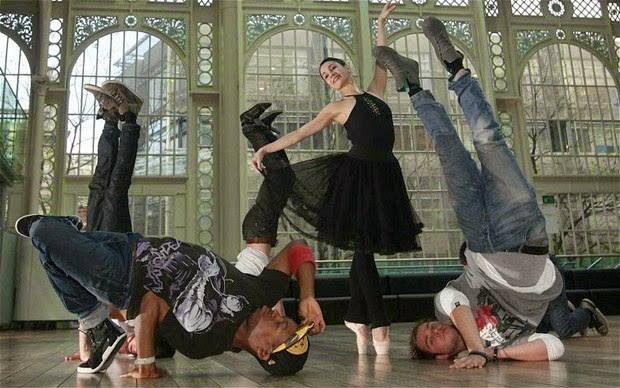INTRO
When I was dancing ballet, my teacher had animosity towards hip-hop for its lack of construct. But it was common for ballerinas to quit ballet to dance jazz or hip-hop instead, and ever the other way. It wasn't until college when I met different dancers who taught me how wonderful and exciting other genre of dance are.
Ballet and hip-hop are considered to be on the opposite sides of the dance spectrum. Not many people can dance both genres (unless you're Alex Wong). In my opinion, Step Up was the ONLY movie that succeeded in collaborating both genres. LXD (the Legion of Extraordinary Dancers) is also very good at collaborating different genres on stage.
The difference in ballet and hip-hop is very obvious. But WHAT is the difference? In this post, I have listed points that came up during a conversation with a b-boy. (Note that these points are from a ballerina's perspective. Some points may not apply to choreography/commercial hip-hop)
OVERVIEW
Ballet has a history of more than 300 years. This form of dance was originally for royalties and people of high socio-economic status. On the other hand, hip-hop became popular in the late 1970's, but derived from earlier dance styles. This form of dance started amongst communities of low socio-economic status. Hip-hop dancers experience injuries in both lower and upper extremities (especially breakdancers), as opposed to the majority of lower extremity injuries in ballet. The setting of hip-hop is moving from streets to studios, as the current industry require fast acquisition of choreography for performances. Hip-hop is a growing industry as it is now implemented in communities as a youth-program. Some hip-hop dancers seek to incorporate ballet techniques for individuality and core strength. Ballet is now adapted as exercise (i.e. Pure Barre, Ballet Beautiful, etc.) for weight-loss.
THE PURPOSE OF DANCE
Ballet: Dancing is a discipline. Dance is being able to show grace through the formation of lines with one's body, and being able to accomplish highly technical skills without seeming to be working hard. Dancers need to replicate dances as precisely as possible. The importance of playing a role is to research and stay in character. If you stop taking classes, you stopped dancing.
Hip-hop: Dancing is a way of expression. Dance shows personality. Replicating dance is "biting," so dancers have to come up with one's own styles and moves. Dancing is about acquiring new skills and taking it to the next level. Once a dancer, always a dancer.
COMPETITION
Ballet: You will see 10 or less different variations. Competitions rarely incorporate self-choreographed pieces. Results are announced after each round of competition. Individuality is important to highlight whether you're a good jumper or a good turner.
Hip-hop: Stereotypically battles. Each dancer is compared to the opponent. Results are announced on spot. Usually improvisation to music of the DJ's choice. Individuality and technicality is important for expression within a given amount of time.
CLASSES AND PERFORMANCES
Ballet: Focus on precision. You will stand out if you're doing something wrong, and that's bad because no one will even look at you. Class structure is usually barre-centre-choreography.
Hip-hop: Focus on individuality. You will not stand out if you're doing what you're told. Your take on music and cool improvisation will get you attention. Classes are not necessary for street styles. Class structure is usually warm-up, then choreography/practice.
PROFESSIONAL LIFESTYLE
Ballet: Aspiring dancers hope to join a ballet company. Secured job but low salary, and threat to lose position after every seasons. Many teach on the side. Training can start as early as 3 years old, and some dancers seek for apprenticeship and professional training programs away from home. Retirement can be around mid to late 30's.
Hip-hop: Aspiring dancers hope to have TV/film appearances, or as background dancers for artists, or as teachers. Less job security, but with the right opportunity, payments of each performances can be adequate or more than adequate. Many teach in studios and guest perform at shows and competitions, or work as full-time in other industry.
DANCING IS DANCING
It is interesting to see the differences, but regardless of the dance values and cultures, they are both considered "dance." Personally, the most interesting aspect to realize was how "boring" ballet is considered to be because there is no improvisation. I had always thought ballet was a form of expression, but how do you express yourself without your own choreography? I recently attended to watch dance battles, and it is exciting. I found hip-hop to be like a conversation where dancers express, and the audience replies with reactions to each moves they liked. Ballet will always be in my heart. But I really want every dancer to experience different dance cultures and not shut them down, because they all have a lot to offer.
Recreationally, it keeps you physically and mentally healthy. So, researchers have been trying to determine the best form of dance to teach in physical education class, but it is important to know that there is no best form of dancing. Art, in general, is a tool for self-expression. Ballet and hip-hop, the two extremities in the dance spectrum, make this form of expression unique and diverse.
Did I miss anything? What do you think is the difference between ballet and hip-hop?
REFERENCES
A community-based hip-hop dance program for youth in a disadvantaged community in ottawa: Implementation findings. (2010). Health Promotion Practice, 11(3), 61S-69S. doi:10.1177/1524839909353738
Ojofeitimi, S., Bronner, S., & Woo, H. (2012). Injury incidence in hip hop dance. Scandinavian Journal of Medicine & Science in Sports, 22(3), 347-355. doi:10.1111/j.1600-0838.2010.01173.x

